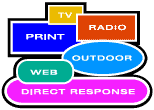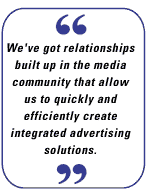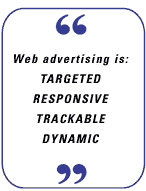 |


|
 |
 |

This article is an excerpt from eMarketing Zone, a bi-weekly newsletter from MarketFirst sent to over 20,000 marketers.
Web Advertising is Alive and Well
eMarketingZone magazine sat down recently with Elaine Starling, principal of Starling Media Services, which specializes in creating media plans and buying advertising space on TV, radio, print, and the web for its clients. In the interview, Elaine explains that, despite the recent downturn in the dot.com industry, web advertising is alive and well, and can still be an important part of any company's overall advertising plan.
eMarketingZone: It seems like putting together a media plan and purchasing ad space is something that internal marketing staff should be able to do. What are the advantages of going outside the company and hiring a firm like Starling Media Services?
 Elaine Starling: For the same reason that marcom managers hire PR agencies, graphic artists, and Web designers' expertise. A good marketing manager would probably be able to put together a pretty decent media plan, and might even be able to negotiate some deals, but it would take a lot of time that could probably be better spent somewhere else. After 18 years in the business, we've got relationships built up in the media community that allow us to quickly and efficiently create integrated advertising solutions that reinforce all other marketing activities, and we regularly save our clients 35-40% off published advertising rates.
Elaine Starling: For the same reason that marcom managers hire PR agencies, graphic artists, and Web designers' expertise. A good marketing manager would probably be able to put together a pretty decent media plan, and might even be able to negotiate some deals, but it would take a lot of time that could probably be better spent somewhere else. After 18 years in the business, we've got relationships built up in the media community that allow us to quickly and efficiently create integrated advertising solutions that reinforce all other marketing activities, and we regularly save our clients 35-40% off published advertising rates.
EMZ: When you're preparing a media plan for a client, what prompts you to include web advertising as a part of the mix?
ES: Internet advertising is a direct response medium that allows you to reach a very targeted audience. I look at the media opportunities against a bulls-eye chart of the advertiser's target audience. The more targeted the medium, the more it reaches the center of the bulls-eye and the more important that it get included in the media mix.
An example might be a client who needs to reach photography enthusiasts. Web advertising can reach sites, email lists and chat rooms all dedicated to photography information -- the center of the bulls-eye. Then I'd overlay the web advertising with magazines that reach photography enthusiasts. The next, broader medium might be on the Travel Channel (cable TV) where we can advertise in programs that offer photography tips. This approach ensures that the majority of people who see the advertising are interested in the product and more likely to respond to the message. Maximizing response to the ad message is my job.
 EMZ: What are the benefits of web advertising?
EMZ: What are the benefits of web advertising?
ES: There are basically four primary benefits. First, you get highly targeted exposure to key audiences. Second, web advertising allows immediate response, enabling prospects to get additional product information in real time. Third, it's trackable, so it provides immediate feedback regarding which advertising creative and placement works. Finally, it's dynamic in that you can use Flash or other animation to capture attention.
EMZ: What types of web advertising do you recommend and why?
ES: People need to remember that web advertising goes way beyond the basic banner. Again, I take a bulls-eye approach that is based on the client's objectives and the historic response rate and ROI of all the web advertising opportunities, usually in the following general order of priority:
1. Search Engine Listings
Search engine listings reach people when they are actively seeking information. These listings are often not perceived to be advertising, but information in response to a specific need. The advertiser can deliver a different message for each key word to further increase response rates. The search engines generate detailed reports that indicate which key words are most popular and which ads generate the most response so that the buy can be optimized over time. The most popular search engines, and the ones that will get you the most bang for your buck, are Google, Lycos, Goto.com, MSN????
2. eNewsletter advertising or sponsorships
A text ad in an eNewsletter allows the advertiser 6-8 lines of copy to describe the product benefits, but no visual image. Advertisers are perceived as offering valuable information when they appear in eNewsletters with relevant editorial content. The newsletter may be saved for future reference and/or distributed to others, offering expanded distribution of the ad message. However, eNewsletters do not offer sophisticated tracking, so an advertiser can't confirm how many people have received the newsletter and viewed their ad, only how many have responded to it.
3. Email blasts using rented lists
Renting a targeted email list can be expensive, but the response rates are usually strong. As with eNewsletters, email lists are selected for audiences with interests very similar to the advertiser's product. A list serve service is used to distribute the ads and click throughs are measured by the client to establish the response rate. Email messages allow for longer copy so an advertiser can thoroughly explain the product benefits. Ensuring that compelling copy is used is imperative to deliver a successful, responsive email blast campaign.
4. Web site sponsorships (far more than just a banner)
Advertisers can benefit from integrated exposure on a highly relevant web site, sponsoring a specific topic or section and blanketing an entire area of the site with logos, banners, skyscrapers, even mini-search areas. This approach establishes the advertiser as "best of breed" on the sponsored topic, encouraging viewers to buy the advertisers' product if they want to work with - what appears to be - a leader in the field.
5. Banner ads
I liken banners to the out-of-home advertising — viewers see the messages briefly while driving down the highway, but the creative must really stand out to capture attention. Banners can be effective for an awareness campaign, but they are not strong for generating traffic to a web site. If the advertiser has a simple message and interesting (animated) graphics, banners catch viewers' attention long enough to get the tag line established.
EMZ: Do you have any concerns or limitations for advertisers who want to use web advertising?
ES: It's not enough to rely on an outside service to track the advertising for impressions and click throughs. The advertiser must have a closed loop measurement system in place that allows them to capture the origin of the viewer, which pages they visit, and what action they take (purchases, etc.) so that a clear cost-per-acquisition and cost-per-sale can be measured. Without this data, web advertising becomes solely an awareness-generation tool and not the direct response medium it should be.
This article is an excerpt from eMarketing Zone, a bi-weekly newsletter from MarketFirst sent to over 20,000 marketers.
Copyright © 2001 Starling Media Services, Inc.
|
 |
 |



